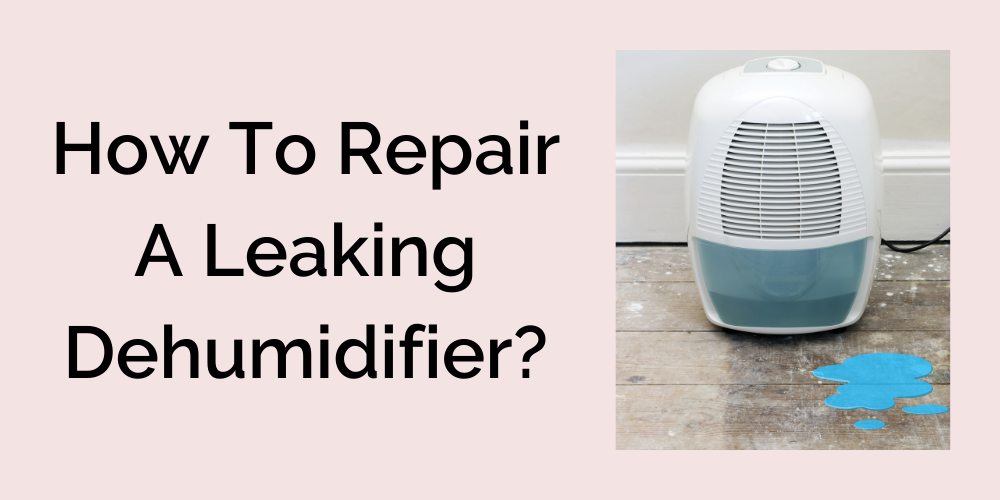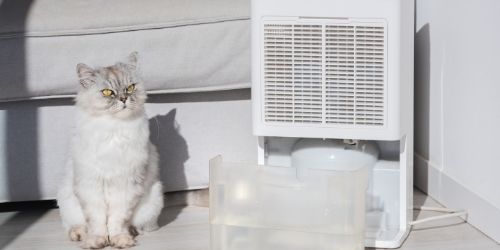Why is my dehumidifier leaking?
3 Key Takeaways:
🚀 Some common causes of a dehumidifier leak include a crack in the water collection bucket, a small water pipe, a disconnected drain hose, frozen coils, and a jammed pump.
🚀 A dehumidifier leaking water onto the floor is not an uncommon scenario.
🚀 There might be a few areas to pay close attention to check if the dehumidifier leaking water onto the floor can be fixed.
A dehumidifier leaking water onto the floor is not an uncommon scenario. To understand why is my dehumidifier leaking, there might be a few areas to pay close attention to check if the dehumidifier leaking water onto the floor can be fixed. Ensuring the dehumidifier unit, drain hole, blocked hose, hose adapter, water collection bucket, float switch or overflow switch, drip tray, and other parts that could cause dehumidifier units to leaking water are fixed to perfection, will remove the problem for you.
Let us take a look at the various problems that will help you identify if the leaking dehumidifier can be fixed and what is causing the dehumidifier unit to leak water onto the floor.
What causes my dehumidifier to leak water?
At the first sign of a dehumidifier leak, anyone will rush to look to the unit if it is leaking from the bottom. Here are other issues that might cause a dehumidifier to leak.
Crack in the water collection bucket
Having a crack in the water collection bucket is one of the most obvious and common reasons to have a leaking dehumidifier. Water leaking from the water collection bucket must be removed immediately to prevent standing water. Water leaking from the collection bucket can be due to a very old collection bucket or a bucket that has eventually broken from the fluctuating temperatures as a result of water collecting.
Water pipe is small
If your unit generally works fine but you are unable to break free from the dehumidifier leaking water, you must check the drain hose or garden hose. When most dehumidifiers have a perfect water bucket and water collection system, sometimes you might run into dehumidifier leaks even after you have a unit fixed if the drain hose is too small.
Drain hose is disconnected
In most dehumidifiers, the water leak could be from a disconnected garden hose. As the temperature rises and drops, the water collecting system may grow weak and lead to drain tube disconnecting. With a properly installed drain hose or garden hose and fixed dehumidifiers, you can stop a dehumidifier leak.
Frozen coils
When dehumidifiers remove moisture, the unit is exposed to temperature rises and temperature fluctuations. As the room’s temperature changes and the dehumidifiers pull air, the unit may end with frozen coils when there is an issue with the fan, compressor, or cool coils. When ice melts and water is leaking from the bottom onto the floor, you will have standing water.
Nowadays, most dehumidifiers come with de-ice feature on the cool coils that can prevent frozen coils and help to drain the unit efficiently.
Jammed pump
Debris inside the condensate pump can also cause dehumidifier leaks. A jammed pump is as bad as a faulty connection in the water collection system. If you have a dehumidifier leaking water onto the floor, check if you have to fix the condensate pump and clear the debris inside.
How to fix a leaking dehumidifier

A dehumidifier leaking water is a possibly hazardous situation, be it in a crawl space or a bedroom. The standing water is a breeding ground for mold and bacteria and a possibly hazardous situation if the dehumidifier leaking water onto the floor is close to a wall socket, loose wires, etc.
Here are some ways to have fixed dehumidifiers to resolve the issue.
- If the dehumidifier is leaking water onto the floor, head to check if you have a properly installed drain pan, water bucket, drain hose, hose adapter, etc. An improperly installed system can cause a dehumidifier to leak water.
- To break free from leaks that happen from improper positioning of the hose, ensure that the unit is mounted high so that the water can flow down freely without causing bends in the hose. This method generally works fine for most homes even can be arranged by creating an elevated area to place the unit.
- Fix condensate pump and have the unit fixed, keeping it free from loose wires.
- Any block in the drain hose must be removed. Cleaning the drain hose is easy with hot soapy water. You can flush out the debris from inside the drain hose by pouring in hot soapy water and using a soft cloth to wipe it off.
- The modern dehumidifiers come with an overflow switch. An overflow switch ensures that the unit turns off automatically and the water bucket does not overflow. Sitting water or water leaking onto the floor from an overflowing water bucket can be successfully avoided with the overflow switch. However, if the overflow switch stopped working, you will have the unit leaking water onto the floor. If the overflow sitch stopped working, fix it at the earliest to stop water sitting on the floor.
- De-ice the coils if they are frozen. As the ice melts from the frozen coils, you will have leaks from the unit happening. Solving this issue ensures you stop the dehumidifier from leaking onto the floor.
5 Unhealthy Mistakes People Make With Dehumidifiers

The best way to avoid facing the question of why is my dehumidifier leaking is to simply practice good use of the unit. Often a few corrections in use of the unit will keep preventing the dehumidifier from leaking water onto the floor. Here are a few mistakes to avoid a water leaking dehumidifier unit.
1. Water bucket misaligned
The water collection bucket that holds the water collected after the dehumidifier pulls air must be fixed correctly. You will have water on the floor even if the drain hose and floor drain are perfect. If the drip tray or drain pan or the water bucket are misaligned, you will have water sitting around the unit.
2. Blocked hose for the drain
A blocked hose with debris is another reason if the dehumidifier is leaking. Fix the blocked hose by regular cleaning to prevent standing water and unpleasant odor. A hose blocked with debris might seem like a small problem but it isn’t.
3. Drain pipe is bent
Failing to keep drain pipe free from bents is another mistake. The pipe must lead from an elevated position to the drain floor. The hose blocked at the point of bents can be avoided by making sure the unit is mounted high so water passes from an elevated position.
4. Hose fitting cap is loose
A faulty connection is also a mistake to have a dehumidifier leaking water. If a dehumidifier is leaking water at the connecting joint to the unit, it could mean that the fitting cap is loose and the problem is not a blocked hose. A faulty connection can be fixed by simply tightening the cap.
5. Vertically coiled drain hose
Water will flow back into the unit and cause a dehumidifier leak if there is vertical coiling of the drain coil. This is yet another mistake to avoid.
Which is the best dehumidifier with a built-in pump?
The Tosot dehumidifier is the best model with a built-in pump. Tosot dehumidifier with a condensate pump is indeed a good investment for a home. It offers complete package of advanced features with whisper quiet operation. According to us, Tosot dehumidifier is the best as far as built in pump feature is considered.
FAQ Section
1. How much water is normal in dehumidifier?
The amount of water the collection bucket stores in a day largely depend on the rate at which dehumidifiers pull air. Each model will differ in the amount of water they can store and extract from the surrounding.
Ideally, an average-sized dehumidifier has been found to collect 10 to 10 liters of water per day. If there is an excess source of water like fresh water or a water leak that has led to more sitting water in the area, the amount of water collected might be more. Large dehumidifiers can even go to collect up to 50 liters of water per day.
2. Where is the float switch on a dehumidifier?
The float switch is located near the bucket. The switch works by the float mechanism and is important to prevent any overflow water from hitting the ground. The switch mechanism will activate the auto shut-off feature in the bucket.
It is important to always keep track of whether the overflow switch is in proper working condition. If the switch has an error and malfunctions, you might end up with a unit that overflows.
3. What to do if dehumidifier won’t drain?
Here are a few of the many areas to look into if your unit is not draining water. The drain hose, floor drain, pump, drain hole, water reservoir, the humidity level in the room, internal parts, etc.
A drain hose that has blocks or bends in it, or has not been routed properly will be unable to effectively drain the unit. Additionally, if the humidity level in the room has not been identified by the device correctly, and there isn’t any moisture left to extract, the unit will not have any water left to drain.
4. Where do you drain a dehumidifier with a pump?
A dehumidifier unit with a pump can be drained via an internal condensate pump or an external condensate pump. The internal pump can be connected to any external drain point. If your unit does not have an internal pump, you can connect an external hose and attach it to the unit to drain the water
Wrapping Up
That’s a wrap to the article that explains ‘Why is my Dehumidifier Leaking’. We trust you found the information helpful. Put into practice the tips and tricks mentioned; right from using the drain hose correctly to using a soft cloth and soapy water to clean out the debris from a blocked hose, or fix the condensate pump and the wall socket, to prevent hazards from the water leaking onto the floor.
Remember the more water passes into the ground of your crawl space or floor, the dehumidifier is leaking from the bottom, apart from the unpleasant odor that your home has, when a dehumidifier is leaking the space is a breeding ground for mold and fungal growth. Ensure the fluctuating temperatures or room’s temperature does not have an effect on the device by maintaining it in good condition and helping the unit efficiently.

About The Author
Olivia — a self-confessed air quality addict — is a home climate enthusiast, fresh air advocate, and someone with deep personal experience and knowledge about mold extermination. Her work was mentioned in countless notable humidity publications. Previously she was an editor at Mold Remediation.